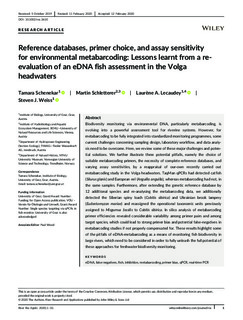| dc.contributor.author | Schenekar, Tamara | |
| dc.contributor.author | Schletterer, Martin | |
| dc.contributor.author | Lecaudey, Laurene Alicia | |
| dc.contributor.author | Weiss, Steven | |
| dc.date.accessioned | 2020-03-04T09:28:04Z | |
| dc.date.available | 2020-03-04T09:28:04Z | |
| dc.date.created | 2020-03-02T19:03:04Z | |
| dc.date.issued | 2020 | |
| dc.identifier.issn | 1535-1459 | |
| dc.identifier.uri | http://hdl.handle.net/11250/2645117 | |
| dc.description.abstract | Biodiversity monitoring via environmental DNA, particularly metabarcoding, isevolving into a powerful assessment tool for riverine systems. However, formetabarcoding to be fully integrated into standardized monitoring programmes, somecurrent challenges concerning sampling design, laboratory workflow, and data analy-sis need to be overcome. Here, we review some of these major challenges and poten-tial solutions. We further illustrate three potential pitfalls, namely the choice ofsuitable metabarcoding primers, the necessity of complete reference databases, andvarying assay sensitivities, by a reappraisal of our-own recently carried outmetabarcoding study in the Volga headwaters. TaqMan qPCRs had detected catfish(Silurus glanis) and European eel (Anguilla anguilla), whereas metabarcoding had not, inthe same samples. Furthermore, after extending the genetic reference database by12 additional species and re-analysing the metabarcoding data, we additionallydetected the Siberian spiny loach (Cobitis sibirica) and Ukrainian brook lamprey(Eudontomyzon mariae) and reassigned the operational taxonomic units previouslyassigned toMisgurnus fossilistoCobitis sibirica. In silico analysis of metabarcodingprimer efficiencies revealed considerable variability among primer pairs and amongtarget species, which could lead to strong primer bias and potential false-negatives inmetabarcoding studies if not properly compensated for. These results highlight someof the pitfalls of eDNA-metabarcoding as a means of monitoring fish biodiversity inlarge rivers, which need to be considered in order to fully unleash the full potential ofthese approaches for freshwater biodiversity monitorin | nb_NO |
| dc.language.iso | eng | nb_NO |
| dc.publisher | Wiley | nb_NO |
| dc.rights | Navngivelse 4.0 Internasjonal | * |
| dc.rights.uri | http://creativecommons.org/licenses/by/4.0/deed.no | * |
| dc.title | Reference databases, primer choice, and assay sensitivity for environmental metabarcoding: Lessons learnt from a re‐evaluation of an eDNA fish assessment in the Volga headwaters | nb_NO |
| dc.type | Journal article | nb_NO |
| dc.type | Peer reviewed | nb_NO |
| dc.description.version | publishedVersion | nb_NO |
| dc.source.journal | Rivers Research and Applications: an international journal devoted to river research and management | nb_NO |
| dc.identifier.doi | 10.1002/rra.3610 | |
| dc.identifier.cristin | 1799085 | |
| dc.description.localcode | This is an open access article under the terms of the Creative Commons Attribution License, which permits use, distribution and reproduction in any medium,provided the original work is properly cited.© 2020 The Authors.River Research and Applicationspublished by John Wiley & Sons Ltd | nb_NO |
| cristin.unitcode | 194,31,10,0 | |
| cristin.unitname | Institutt for naturhistorie | |
| cristin.ispublished | true | |
| cristin.fulltext | original | |
| cristin.qualitycode | 1 | |

